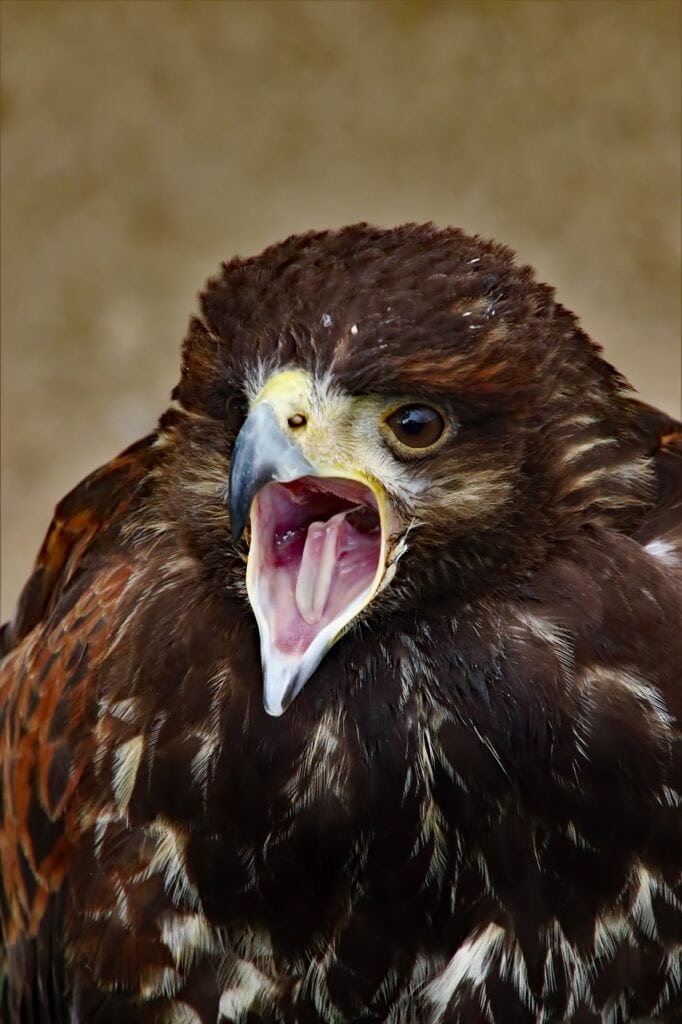Having trained Harris Hawks for years, I know how crucial it is to respect their natural instincts during training. Setting up varied perches, creating safe spaces, and establishing clear boundaries are key. Building trust through time and attention, along with a balanced diet and implementing positive reinforcement, forms a strong foundation. Allow me to guide you through the process of preparing for your training with a Harris Hawk using the information provided below.
Understanding Harris Hawk Behavior
Understanding the behavior of the Harris Hawk is crucial for successful training and bonding with this magnificent bird of prey. In the wild, Harris Hawks exhibit a complex social hierarchy, working together in groups to hunt and survive. When training these hawks, it’s essential to respect their innate hunting instincts. We can effectively channel this energy into training exercises by understanding their natural drive to hunt.

Communication cues play a significant role in building a strong bond with your Harris Hawk. These birds are highly perceptive to body language and vocal cues, making establishing clear signals during training sessions vital. Additionally, environmental enrichment is key to keeping your hawk mentally stimulated and engaged. Providing a variety of perches, toys, and interactive activities can prevent boredom and encourage natural behaviors.
Employing bonding techniques such as positive reinforcement and consistent training routines is paramount to strengthening the bond with your Harris Hawk. By reinforcing desired behaviors with rewards and spending quality time together, you will establish trust and mutual respect, paving the way for a successful training journey.
Setting Up the Training Environment
Creating an optimal training environment for your Harris Hawk is essential for fostering effective learning and bonding experiences. To set up the perfect space, follow these key steps:
- Creating Perches: Install various perches at different heights to mimic natural hunting environments and encourage exercise and exploration.
- Providing Shelter: Offer a sheltered area in the training environment where your hawk can rest and feel secure, especially during extreme weather conditions.
- Setting Boundaries: Establish clear boundaries using physical barriers or visual markers to define the training area and prevent your hawk from wandering off.
- Introducing Prey: During training sessions, gradually introduce live prey to stimulate the hawk’s natural hunting instincts and maintain its predatory skills.
Establishing Trust and Bonding
As I guide my Harris Hawk through the training process, building trust and fostering a strong bond forms the foundation for successful partnership and effective communication. Building rapport with my hawk is essential; I spend time near the bird, allowing it to become comfortable with my presence. This gradual approach helps create a connection based on trust and respect. Through consistent interaction, I establish boundaries that help the hawk understand expectations while ensuring its well-being. By setting clear boundaries, the hawk learns to trust me as its handler, knowing that I will provide guidance and protection.
Fostering communication is key in our partnership. I pay close attention to the hawk’s body language and vocalizations, learning to interpret its needs and emotions. This mutual understanding deepens our bond and enhances our training sessions.

Implementing Training Techniques
Positive reinforcement is key in training a Harris Hawk. By rewarding desired behaviors with treats or praise, the hawk learns to associate those behaviors with positive outcomes, making them more likely to repeat them. Flying exercises are crucial for keeping the hawk fit and mentally stimulated. Regular flying sessions improve hunting skills and build trust between us. The equipment needed for training includes a well-fitted leather glove for handling and training aids like lures or creance lines to guide the hawk during flight. Socialization with other birds is essential for the hawk to develop proper social behaviors and maintain its natural instincts. Lastly, mastering proper handling techniques is vital to ensure the hawk’s safety and well-being during training sessions. By incorporating these elements into our training routine, my Harris Hawk and I continue to grow together in skill and companionship.
Training a Harris hawk is a rewarding journey that requires patience, dedication, and, most importantly, a deep understanding of its behavior. You can develop a strong partnership with your hawk by creating a strong bond based on trust and respect, providing a balanced diet, and implementing effective training techniques. Remember to always prioritize their well-being and happiness throughout the training process. With time, effort, and love, you can enjoy the incredible experience of flying your well-trained Harris hawk.

